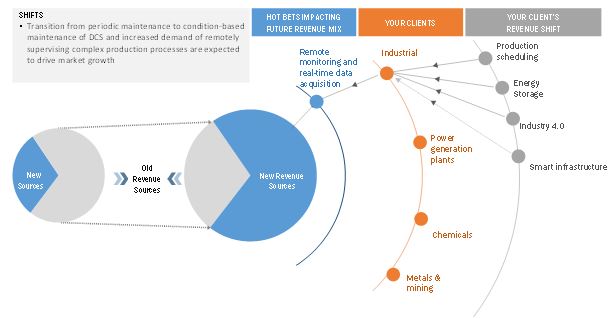The Distributed control system market is expected to grow from an estimated USD 17.5 billion in 2021 to USD 23.2 billion by 2026, at a CAGR of 5.8% during the forecast period. Booming power sector and augmented power generation capacities worldwide offer huge opportunity for Distributed control system market. There has been a steady increase in the global demand for power, due to which substantial investments have been made, especially in regions such as the Middle East, Asia Pacific, and Africa, to augment the power generation capacities. Investments in conventional power generation in Middle Eastern countries such as Egypt and Oman and renewable power generation in Asia Pacific and African countries such as China, India, and South Africa have been planned to meet the increasing demand for power.
Download PDF Brochure – https://www.marketsandmarkets.com/pdfdownloadNew.asp?id=239430160
Asia Pacific is expected to grow at the highest CAGR during the forecast period. Asia Pacific region has been segmented, by country, into China, India, Japan, South Korea, and Rest of Asia Pacific. Rest of Asia Pacific includes Indonesia, Thailand, Bangladesh, Australia, Laos, Cambodia, Myanmar, and Vietnam. The Distributed control system marketin this region is expected to grow due to rapid regional industrialization, urbanization, and economic growth, which are leading to the installation of new DCS.
A distributed control system (DCS) is employed for the handling of processes and plants to provide better control, safety, and product efficiency and quality at plants. Distributed control systems find applications in industries such as oil & gas, power generation, paper & pulp, food & beverages, pharmaceuticals, and chemicals to mainly control manufacturing through two processes: batch-oriented and continuous. The batch-oriented process is used when the production is carried out in subsequent batches, while the continuous process is used for the production type where the production flow does not involve any interruption. Distributed control systems localize the control functions near the process plant. which helps reduce the requirement of monitor/screen, as the process variables can be monitored remotely and decision can be taken accordingly.
Make an Inquiry – https://www.marketsandmarkets.com/Enquiry_Before_BuyingNew.asp?id=239430160
The Distributed control system market, by shipment scale, into large, medium, and small. The Distributed control system market, by component, into up to hardware, software and services. The Distributed control system market, by application, into continuous and batch-oriented process. The Distributed control system market, by end-use industry, into oil & gas, power generation, chemicals, food & beverages, pharmaceuticals, metals & mining, paper & pulp, and others, which includes cement, glass, sugar, and water & wastewater treatment.

The software segment is expected to hold the highest market share during the forecast period. The software segment includes IT applications such as advanced process control systems, controller integration with DCS, technology libraries, telecontrol software, connectivity solutions, parameter control and materials management systems, process optimization and process safety solutions, and advanced software and virtualization solutions. It offers a common platform for devices to connect and operate.
The continuous process market, by application, is expected to hold the highest market share during the forecast period. The continuous process segment accounted for the largest share of 66.4% in 2020. The continuous process is a method where the manufacturing process is carried out without any interruption and is generally preferred when producing large quantities. It is the faster-growing application in the Distributed control system market. The continuous production process is used in oil & gas, chemicals, power generation, and water & wastewater treatment industries and is one of the more efficient and profitable methods of production. The use of distributed control systems in nuclear as well as renewable sectors in the power generation industry and in upstream and downstream activities in the oil & gas industry are the major factors driving the continuous process segment. The increasing production of chemicals and the growing demand for distribution control systems in the refining industry also contribute to the segment’s growth.
Ask Sample Pages – https://www.marketsandmarkets.com/requestsampleNew.asp?id=239430160
The oil & gas market, by end-use industry, is expected to hold the highest market share during the forecast period. The oil & gas segment accounted for the largest market share of 25.9% in 2020. The oil & gas segment, consists of petrochemicals, refining, and oil & gas extraction. Oil & gas is one of the largest industries in terms of revenue generation for the Distributed control system market and is classified into 3 major sectors—upstream, midstream, and downstream. The upstream sector involves the extraction, development, and production of crude oil and natural gas, the midstream sector includes the transportation and storage of crude oil and refined petroleum products, and the downstream sector consists of companies involved in refining crude oil, producing petroleum products, and selling these products through wholesale and retail channels. The processes carried out in this industry are highly complex, lengthy, and critical. Distributed control systems are widely applied across all sectors of the oil & gas industry, as these systems ensure safety, reliability, and profitability in oil & gas operations.
